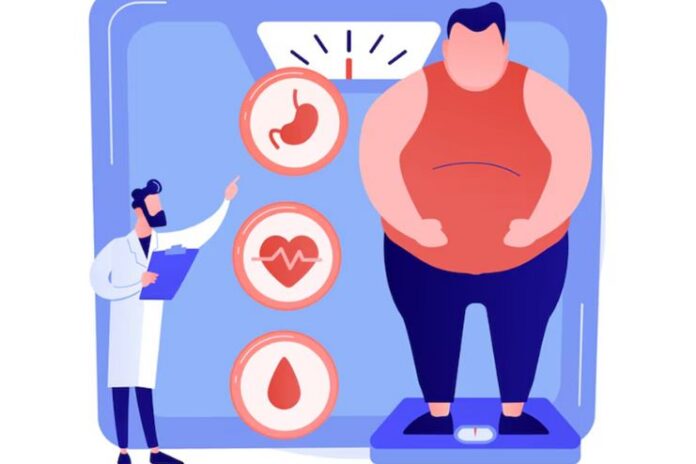Affiliate Disclaimer
Some links in this article are affiliate links. We may earn a small commission if you make a purchase through these links, at no extra cost to you. We only recommend products we find useful to our readersObesity has been recognized as a major public health concern around the globe. Its prevalence rates are increasing in all age groups and populations. Defined by excessive fat accumulation and commonly measured by the Body Mass Index (BMI), obesity is linked to numerous health issues, including cardiovascular diseases, certain cancers, and, most critically, type 2 diabetes.
The relationship between obesity and type 2 diabetes is particularly concerning. People who are obese are more likely to experience insulin resistance, where the body’s cells fail to respond to insulin, leading to high blood sugar levels.
So, there is a need for knowledge of how obesity can increase the risk of developing diabetes, as well as prevention and management. Understanding the mechanisms is essential to controlling this epidemic and promoting a healthy lifestyle for you and the coming generations.
Mechanisms of Obesity Leading to Diabetes

Insulin Resistance
Insulin is a hormone produced by the pancreas that allows cells to absorb glucose for energy. However, excess fatty tissue, particularly visceral fat, interferes with insulin’s effectiveness. This condition, known as insulin resistance, forces the pancreas to produce more insulin to maintain normal blood glucose levels. Over time, the pancreas struggles to keep up, leading to high blood sugar levels—a key risk factor for developing type 2 diabetes. Read more about glucose absorption here.
Chronic Inflammation
Additionally, adipose (fat) tissue is not just a passive energy store; it is an active endocrine organ. In obese individuals, fat tissue produces inflammatory cytokines, contributing to chronic low-grade inflammation. This inflammation disrupts insulin signaling, exacerbating insulin resistance and increasing the risk of diabetes.
Hormonal Imbalances and Diabetes Risk
Obesity also disrupts several key hormones involved in regulating appetite and metabolism. One of these is leptin, which helps control hunger and energy balance. In obese individuals, leptin resistance can occur, making it less effective in suppressing appetite and promoting weight gain, which further increases the risk of type 2 diabetes.
Another important hormone is adiponectin, which is known to enhance insulin sensitivity and has anti-inflammatory effects. Unfortunately, levels of adiponectin are typically lower in obese individuals, contributing to higher insulin resistance and a greater risk of developing diabetes.
The Role of Visceral Fat

Subcutaneous vs. Visceral Fat
- Subcutaneous fat forms right under the skin. It is less damaging than visceral fat, but it also contributes to overall body weight.
- Visceral fat surrounds vital internal organs such as the liver, pancreas, and intestines. It is metabolically active and releases several inflammatory substances and hormones, disrupting normal body functions.
Why Visceral Fat Is More Dangerous
Visceral fat is associated with a higher incidence of type 2 diabetes and various other metabolic disorders. Unlike subcutaneous fat, visceral fat directs its free fatty acid and inflammatory cytokine products into the bloodstream, increasing insulin resistance and systemic inflammation.
The presence of visceral fat is the most important indicator of metabolic syndrome, which includes several risks for diabetes and cardiovascular diseases.
Lifestyle Factors Contributing to Obesity and Diabetes
- Dietary Habits

- Processed Foods and Weight Gain: Consuming processed foods is a major contributor to obesity and diabetes risk. These foods are typically high in unhealthy fats, added sugars, and refined carbohydrates but low in essential nutrients. As a result, they provide excessive calories without offering the body the nourishment it needs, leading to an energy imbalance. Overconsumption of processed foods can result in weight gain and poor metabolic health, increasing the risk of developing type 2 diabetes.
- Sugary Drinks and Their Impact: Sugary beverages, such as sodas, energy drinks, and sweetened teas, are strongly linked to weight gain and an increased risk of diabetes. These drinks are high in empty calories and often consumed in large quantities, leading to a surplus of calories without providing any nutritional value. Regular consumption of sugary drinks can lead to insulin resistance, a key factor in the development of type 2 diabetes, while also promoting fat storage and contributing to obesity.
- Exercise Habits

- Sedentary Lifestyle: A lack of regular physical activity is a key factor contributing to both obesity and diabetes risk. When we fail to exercise, calorie expenditure decreases, and excess calories are stored as visceral fat, which contributes to insulin resistance. This makes it harder for the body to regulate blood sugar levels and increases the risk of developing diabetes.
- Benefits of Regular Exercise: Engaging in regular physical activity, such as walking, running, or strength training, has a significant positive impact on insulin sensitivity. Exercise helps burn calories, reduces visceral fat, and improves metabolic health, which lowers the risk of developing type 2 diabetes.
- The Role of Daily Movement: Small changes in daily habits, such as taking the stairs instead of the elevator, walking short distances, or incorporating stretching during breaks, can help combat the negative effects of a sedentary lifestyle. These simple activities can boost metabolism and improve overall health, reducing the risk of obesity and diabetes.
- Effects of Stress, Poor Sleep, and Mental Health

- Stress and Emotional Eating: Stress and anxiety often trigger emotional eating, leading individuals to consume unhealthy, high-calorie foods as a way to cope. This overeating contributes to weight gain, which can increase the risk of obesity and type 2 diabetes. Chronic stress can also disrupt the body’s ability to manage blood sugar levels, further exacerbating the risk of metabolic issues.
- Impact of Poor Sleep on Hunger and Appetite: Sleep deprivation has a profound effect on the hormones that regulate hunger, such as ghrelin and leptin. When sleep is insufficient, ghrelin (the hunger hormone) levels rise, and leptin (the hormone that signals fullness) decreases, leading to increased cravings for unhealthy foods. This hormonal imbalance can reduce motivation to follow healthy routines and increase the risk of obesity and diabetes.
Genetic and Socioeconomic Factors

The Role of Genetics and Family History
Genetics play a crucial role in determining body weight and fat distribution. Specific genes influence appetite regulation, metabolism, and fat storage, making some individuals more susceptible to obesity. Studies suggest that genetics account for 40-70% of the variation in body mass index (BMI), indicating that a significant portion of weight gain risk is inherited.
However, genetic predisposition to obesity does not operate in isolation. It interacts with environmental and lifestyle factors, such as diet and physical activity, which can either amplify or mitigate the genetic risks. In this way, even with a genetic vulnerability, lifestyle choices can play a key role in managing or preventing obesity.
Socioeconomic Barriers to Healthy Living
In addition to genetic factors, socioeconomic challenges can significantly impact the ability to maintain a healthy lifestyle. Many individuals in lower-income communities face barriers such as limited access to affordable, nutritious food. Food deserts—areas lacking fresh produce—often force residents to rely on convenience stores or fast-food outlets, which typically offer calorie-dense, nutrient-poor options.
Furthermore, the high cost of fresh fruits, vegetables, and lean proteins makes healthier eating choices unattainable for many families. These economic constraints, combined with the availability of cheaper, unhealthy alternatives, create a cycle that is difficult to break. As a result, genetic risks for obesity are compounded by socioeconomic factors, making it harder for some individuals to make healthier lifestyle choices.
Conclusion
Obesity is a major risk factor for developing type 2 diabetes, largely driven by genetic predisposition, poor lifestyle choices, and psychological factors. Obesity can impair insulin function, contribute to overeating due to emotional stress, and create barriers to maintaining a healthy diet.
To effectively manage and prevent obesity-related diabetes, a comprehensive approach is essential. This includes adopting a balanced diet, staying physically active, and prioritizing mental health. Understanding the connection between obesity and diabetes can help you develop targeted prevention strategies, empowering you to make healthier choices and reduce your risk.
In this Article



















